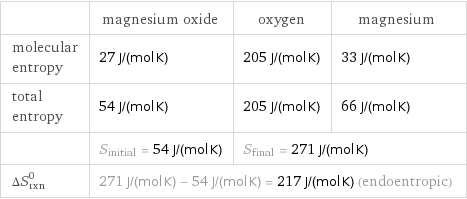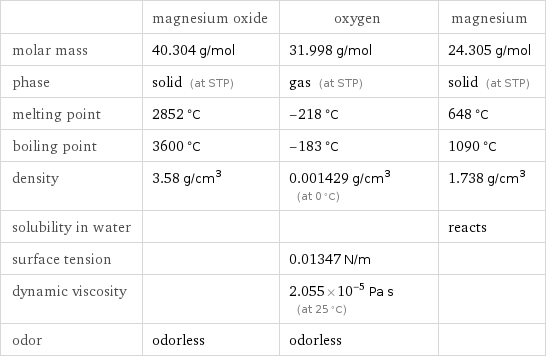Input interpretation

MgO magnesium oxide ⟶ O_2 oxygen + Mg magnesium
Balanced equation

Balance the chemical equation algebraically: MgO ⟶ O_2 + Mg Add stoichiometric coefficients, c_i, to the reactants and products: c_1 MgO ⟶ c_2 O_2 + c_3 Mg Set the number of atoms in the reactants equal to the number of atoms in the products for Mg and O: Mg: | c_1 = c_3 O: | c_1 = 2 c_2 Since the coefficients are relative quantities and underdetermined, choose a coefficient to set arbitrarily. To keep the coefficients small, the arbitrary value is ordinarily one. For instance, set c_2 = 1 and solve the system of equations for the remaining coefficients: c_1 = 2 c_2 = 1 c_3 = 2 Substitute the coefficients into the chemical reaction to obtain the balanced equation: Answer: | | 2 MgO ⟶ O_2 + 2 Mg
Structures

⟶ +
Names

magnesium oxide ⟶ oxygen + magnesium
Reaction thermodynamics
Enthalpy

| magnesium oxide | oxygen | magnesium molecular enthalpy | -601.6 kJ/mol | 0 kJ/mol | 0 kJ/mol total enthalpy | -1203 kJ/mol | 0 kJ/mol | 0 kJ/mol | H_initial = -1203 kJ/mol | H_final = 0 kJ/mol | ΔH_rxn^0 | 0 kJ/mol - -1203 kJ/mol = 1203 kJ/mol (endothermic) | |
Entropy

| magnesium oxide | oxygen | magnesium molecular entropy | 27 J/(mol K) | 205 J/(mol K) | 33 J/(mol K) total entropy | 54 J/(mol K) | 205 J/(mol K) | 66 J/(mol K) | S_initial = 54 J/(mol K) | S_final = 271 J/(mol K) | ΔS_rxn^0 | 271 J/(mol K) - 54 J/(mol K) = 217 J/(mol K) (endoentropic) | |
Equilibrium constant
![Construct the equilibrium constant, K, expression for: MgO ⟶ O_2 + Mg Plan: • Balance the chemical equation. • Determine the stoichiometric numbers. • Assemble the activity expression for each chemical species. • Use the activity expressions to build the equilibrium constant expression. Write the balanced chemical equation: 2 MgO ⟶ O_2 + 2 Mg Assign stoichiometric numbers, ν_i, using the stoichiometric coefficients, c_i, from the balanced chemical equation in the following manner: ν_i = -c_i for reactants and ν_i = c_i for products: chemical species | c_i | ν_i MgO | 2 | -2 O_2 | 1 | 1 Mg | 2 | 2 Assemble the activity expressions accounting for the state of matter and ν_i: chemical species | c_i | ν_i | activity expression MgO | 2 | -2 | ([MgO])^(-2) O_2 | 1 | 1 | [O2] Mg | 2 | 2 | ([Mg])^2 The equilibrium constant symbol in the concentration basis is: K_c Mulitply the activity expressions to arrive at the K_c expression: Answer: | | K_c = ([MgO])^(-2) [O2] ([Mg])^2 = ([O2] ([Mg])^2)/([MgO])^2](../image_source/0b1ac481ed06bea614097a1552435ec1.png)
Construct the equilibrium constant, K, expression for: MgO ⟶ O_2 + Mg Plan: • Balance the chemical equation. • Determine the stoichiometric numbers. • Assemble the activity expression for each chemical species. • Use the activity expressions to build the equilibrium constant expression. Write the balanced chemical equation: 2 MgO ⟶ O_2 + 2 Mg Assign stoichiometric numbers, ν_i, using the stoichiometric coefficients, c_i, from the balanced chemical equation in the following manner: ν_i = -c_i for reactants and ν_i = c_i for products: chemical species | c_i | ν_i MgO | 2 | -2 O_2 | 1 | 1 Mg | 2 | 2 Assemble the activity expressions accounting for the state of matter and ν_i: chemical species | c_i | ν_i | activity expression MgO | 2 | -2 | ([MgO])^(-2) O_2 | 1 | 1 | [O2] Mg | 2 | 2 | ([Mg])^2 The equilibrium constant symbol in the concentration basis is: K_c Mulitply the activity expressions to arrive at the K_c expression: Answer: | | K_c = ([MgO])^(-2) [O2] ([Mg])^2 = ([O2] ([Mg])^2)/([MgO])^2
Rate of reaction
![Construct the rate of reaction expression for: MgO ⟶ O_2 + Mg Plan: • Balance the chemical equation. • Determine the stoichiometric numbers. • Assemble the rate term for each chemical species. • Write the rate of reaction expression. Write the balanced chemical equation: 2 MgO ⟶ O_2 + 2 Mg Assign stoichiometric numbers, ν_i, using the stoichiometric coefficients, c_i, from the balanced chemical equation in the following manner: ν_i = -c_i for reactants and ν_i = c_i for products: chemical species | c_i | ν_i MgO | 2 | -2 O_2 | 1 | 1 Mg | 2 | 2 The rate term for each chemical species, B_i, is 1/ν_i(Δ[B_i])/(Δt) where [B_i] is the amount concentration and t is time: chemical species | c_i | ν_i | rate term MgO | 2 | -2 | -1/2 (Δ[MgO])/(Δt) O_2 | 1 | 1 | (Δ[O2])/(Δt) Mg | 2 | 2 | 1/2 (Δ[Mg])/(Δt) (for infinitesimal rate of change, replace Δ with d) Set the rate terms equal to each other to arrive at the rate expression: Answer: | | rate = -1/2 (Δ[MgO])/(Δt) = (Δ[O2])/(Δt) = 1/2 (Δ[Mg])/(Δt) (assuming constant volume and no accumulation of intermediates or side products)](../image_source/937b656ccf356b67900cc536053e8c42.png)
Construct the rate of reaction expression for: MgO ⟶ O_2 + Mg Plan: • Balance the chemical equation. • Determine the stoichiometric numbers. • Assemble the rate term for each chemical species. • Write the rate of reaction expression. Write the balanced chemical equation: 2 MgO ⟶ O_2 + 2 Mg Assign stoichiometric numbers, ν_i, using the stoichiometric coefficients, c_i, from the balanced chemical equation in the following manner: ν_i = -c_i for reactants and ν_i = c_i for products: chemical species | c_i | ν_i MgO | 2 | -2 O_2 | 1 | 1 Mg | 2 | 2 The rate term for each chemical species, B_i, is 1/ν_i(Δ[B_i])/(Δt) where [B_i] is the amount concentration and t is time: chemical species | c_i | ν_i | rate term MgO | 2 | -2 | -1/2 (Δ[MgO])/(Δt) O_2 | 1 | 1 | (Δ[O2])/(Δt) Mg | 2 | 2 | 1/2 (Δ[Mg])/(Δt) (for infinitesimal rate of change, replace Δ with d) Set the rate terms equal to each other to arrive at the rate expression: Answer: | | rate = -1/2 (Δ[MgO])/(Δt) = (Δ[O2])/(Δt) = 1/2 (Δ[Mg])/(Δt) (assuming constant volume and no accumulation of intermediates or side products)
Chemical names and formulas

| magnesium oxide | oxygen | magnesium formula | MgO | O_2 | Mg name | magnesium oxide | oxygen | magnesium IUPAC name | oxomagnesium | molecular oxygen | magnesium
Substance properties

| magnesium oxide | oxygen | magnesium molar mass | 40.304 g/mol | 31.998 g/mol | 24.305 g/mol phase | solid (at STP) | gas (at STP) | solid (at STP) melting point | 2852 °C | -218 °C | 648 °C boiling point | 3600 °C | -183 °C | 1090 °C density | 3.58 g/cm^3 | 0.001429 g/cm^3 (at 0 °C) | 1.738 g/cm^3 solubility in water | | | reacts surface tension | | 0.01347 N/m | dynamic viscosity | | 2.055×10^-5 Pa s (at 25 °C) | odor | odorless | odorless |
Units
